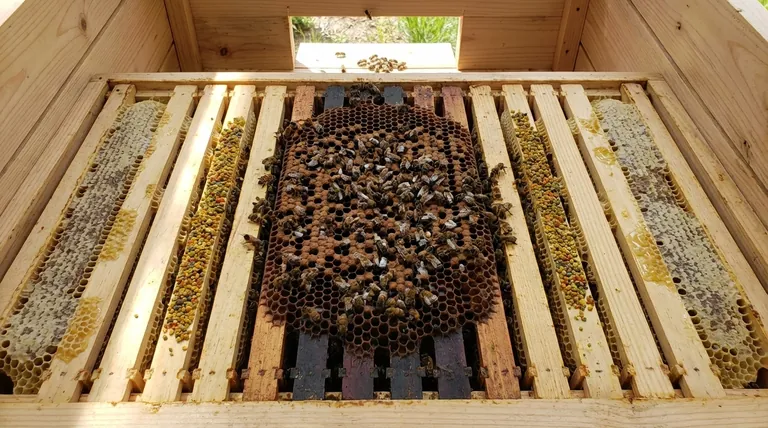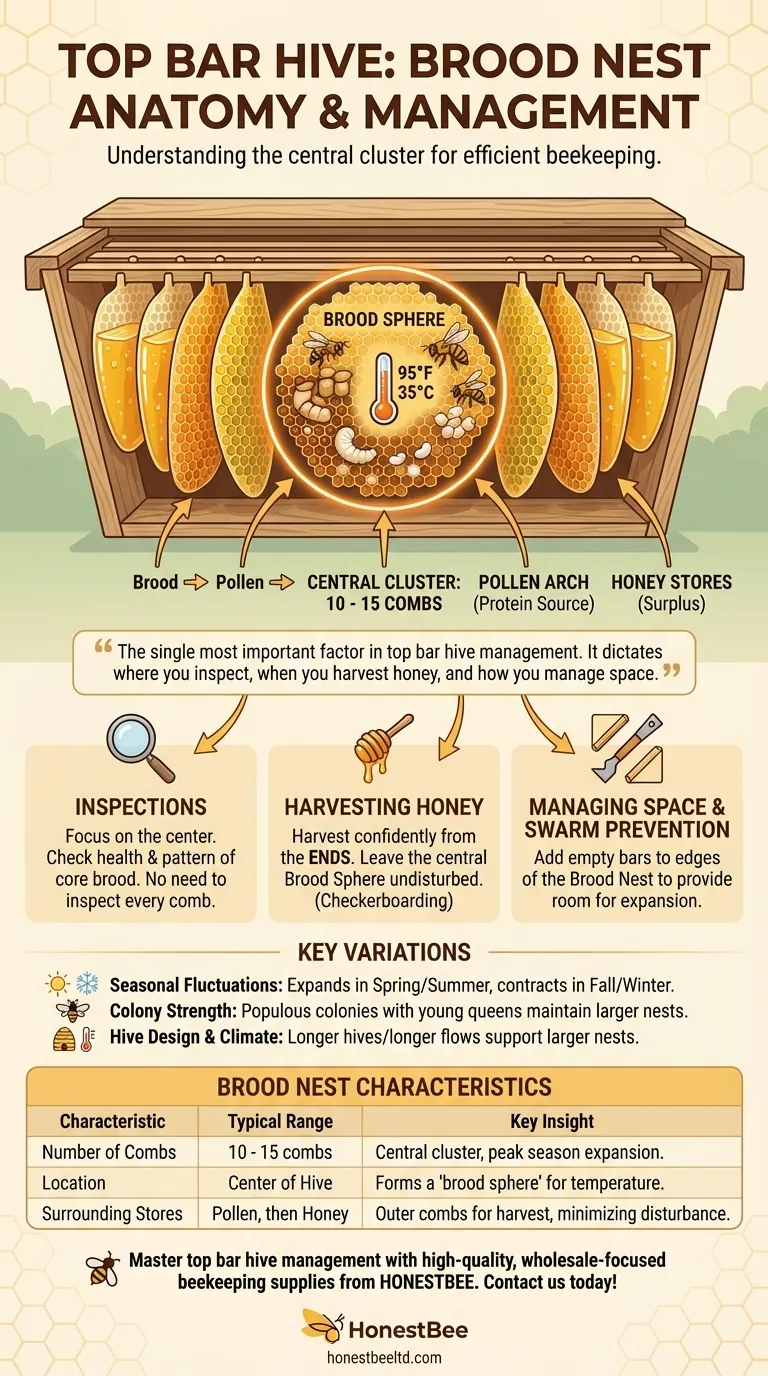In a typical top bar hive, the queen will dedicate a central cluster of 10 to 11 combs for raising brood. This brood nest can expand to as many as 15 combs during peak season in a strong and productive colony. The remaining combs at the ends of the hive are then used by the bees for storing pollen and honey.
Understanding the size and location of the brood nest is the single most important factor in top bar hive management. It dictates where you inspect, when you harvest honey, and how you manage space to ensure the colony remains healthy and productive.

The Anatomy of a Top Bar Hive Brood Nest
A top bar hive is managed horizontally, and the colony organizes itself in a predictable, logical pattern. The brood nest is the colony's heart, both literally and figuratively.
Central Location is Key
The brood nest is almost always located in the center of the cluster of combs. The bees maintain this area at a consistent temperature (around 95°F or 35°C) to incubate the eggs, larvae, and pupae.
As the colony expands or contracts, the entire cluster of bees may shift its position within the hive, but the brood will remain in the middle of that cluster.
The "Brood Sphere"
Bees think in three dimensions. The brood nest isn't just a series of flat combs but forms a cohesive, roughly spherical or oval shape across multiple combs.
The center-most combs will have the largest patches of brood, while the combs on the edges of the nest will have smaller brood patches, transitioning to pollen and then honey. This spherical shape is the most efficient way for the bees to maintain temperature.
How Stores Are Organized
Surrounding this central brood nest, you will find a distinct pattern. Immediately around the brood, the bees will store a "pollen arch" or "pollen wall." This keeps their primary protein source close to the developing larvae.
Beyond the pollen, on the outermost combs at both ends of the hive, the bees will store their surplus honey.
What This Means for Hive Management
Knowing this natural layout empowers you to work with the bees' instincts, not against them.
Identifying the Brood Nest for Inspections
When you inspect, you can quickly locate the brood nest by looking for the most active combs in the center of the cluster. Your primary goal during an inspection is to check the health and pattern of this core brood area.
You do not need to inspect every single comb in the hive. Once you identify the edges of the brood nest, you know the outer combs are dedicated to honey storage.
Harvesting Honey
The most significant advantage of this layout is for harvesting. You can confidently harvest honey combs from the ends of the hive without disturbing the critical brood nest in the center.
This practice, known as "checkerboarding" or simply harvesting from the back, is a core principle of top bar beekeeping.
Managing Space and Swarm Prevention
To give a growing colony more space, you add empty top bars to the edges of the brood nest or to one end of the hive. This gives the queen space to expand her laying and gives foragers room to build comb and store incoming nectar.
Providing this space is a key technique for managing the colony's natural impulse to swarm when it feels crowded.
Understanding Key Variations
The "10 to 15 comb" figure is a strong guideline, but it is not an absolute rule. Several factors can influence the size of the brood nest.
Seasonal Fluctuations
The brood nest is not static. It expands dramatically in the spring and early summer as the queen's laying rate peaks with the nectar flow.
In late summer and fall, the brood nest will naturally contract as the queen reduces her laying in preparation for winter.
Colony Strength and Queen Quality
A strong, populous colony with a young, prolific queen will maintain a larger brood nest than a weaker colony or one with an aging queen. The size of the brood nest is a direct indicator of the colony's overall health and potential.
Hive Design and Climate
The total length of your top bar hive and your local climate will also play a role. A longer hive in a region with a long nectar flow season may support a larger, more sustained brood nest compared to a shorter hive or one in a colder climate.
Applying This to Your Hive
Use your understanding of the brood nest to guide your management decisions based on your specific goals.
- If your primary focus is assessing colony health: Regularly check the central 10-15 combs for a solid, consistent brood pattern, which is the best sign of a healthy queen and colony.
- If your primary focus is maximizing honey harvest: Clearly identify the outer edges of the brood nest and only harvest combs from beyond that point, leaving the colony's core undisturbed.
- If your primary focus is swarm prevention: Add empty bars adjacent to the brood nest or at the far end of the hive during a nectar flow to provide ample room for expansion.
By learning to read the colony's layout, you can manage your hive with minimal disruption and greater success.
Summary Table:
| Brood Nest Characteristic | Typical Range | Key Insight |
|---|---|---|
| Number of Brood Combs | 10 - 15 combs | Central cluster, expands during peak season. |
| Location | Center of the hive | Forms a "brood sphere" for efficient temperature control. |
| Surrounding Stores | Pollen arch, then honey | Outer combs are for honey harvest, minimizing brood disturbance. |
Master the art of top bar hive management with the right equipment.
Understanding the brood nest is crucial, and having reliable, well-designed supplies makes all the difference. HONESTBEE supplies commercial apiaries and beekeeping equipment distributors with high-quality, wholesale-focused beekeeping supplies and equipment.
Whether you need top bars, hive tools, or protective gear, we provide the durable essentials that help you manage your colonies effectively and maximize honey production.
Contact HONESTBEE today to discuss your wholesale needs and equip your operation for success!
Visual Guide

Related Products
- Top Bar Beehive for Beekeeping Wholesales Kenya Top Bar Hive
- Long Langstroth Style Horizontal Top Bar Hive for Wholesale
- HONESTBEE Professional Long Handled Hive Tool with Precision Cutting Blade
- HONESTBEE Professional Multi-Functional Hive Tool with Ergonomic Wood Handle
- HONESTBEE Advanced Ergonomic Stainless Steel Hive Tool for Beekeeping
People Also Ask
- What are the key features of the Kenyan Top Bar Hive? A Guide to Simpler, Natural Beekeeping
- What are the benefits of a top bar hive? A Natural, Low-Impact Approach to Beekeeping
- What are the labor requirements for a KTBH vs. Langstroth hive? A Guide for Apiary Efficiency
- Why are hive inspections easier with Top Bar Hives? Achieve a Calmer, Safer Approach to Beekeeping
- How is honey harvested from a top-bar hive? A Guide to Simple, Low-Equipment Processing



















